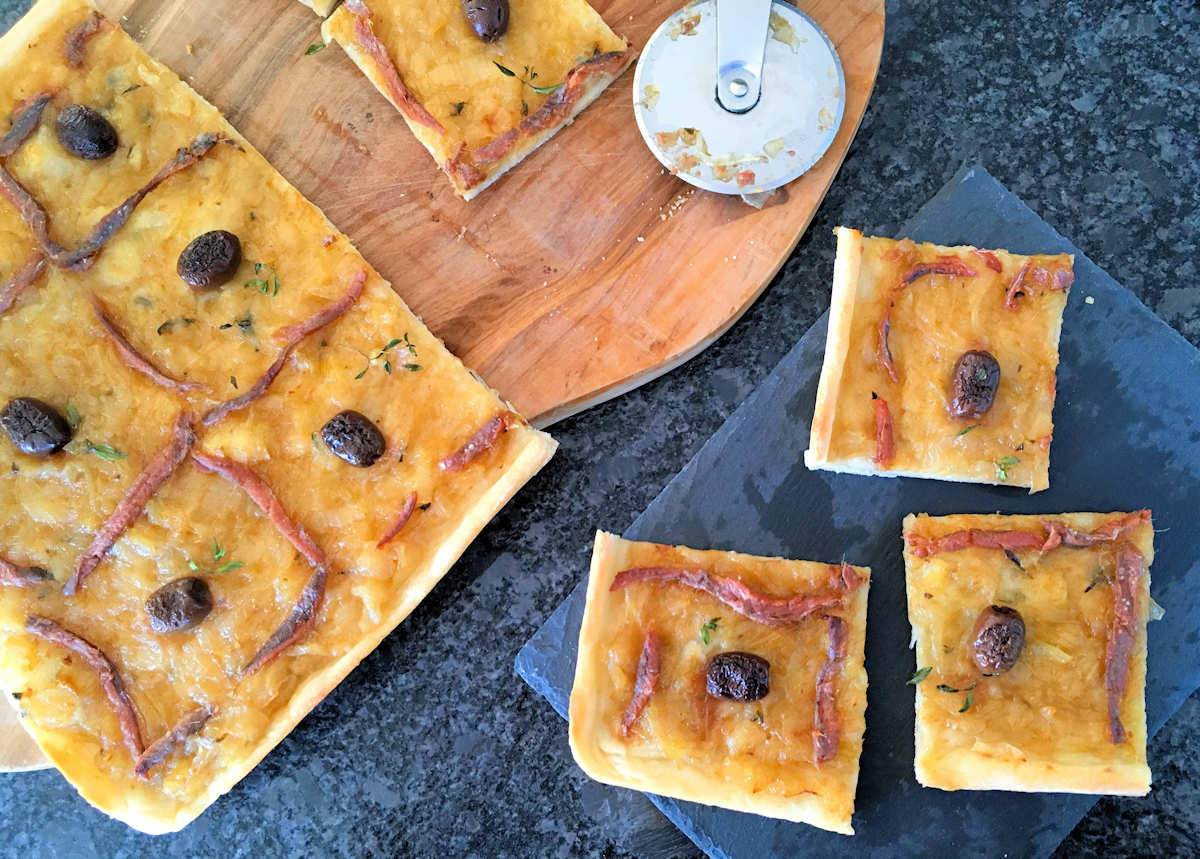The story of pissaladière is an interesting one, albeit falling back on the eternal principle of eating what’s at hand, local and seasonal.

Salty fish
It begins with ordinary salty fish: ‘peis salat’ in Niçard dialect. Salted fish, anchovies and sardines in this instance, are made into a creamy paste by an ancient method of pressing freshly caught tiny young fish, scales, guts and all; with tonnes of herbs and spices, with wooden weights in barrels or receptacles.
The gunk is drained daily and eventually a probably unappetising, non-fragrant grey-pink paste called pissalat is produced.
It must be directly related to ancient Roman garum, to oyster sauce and to fish sauce – each unbelievably potent encapsulation of umami: fishy, salty, herby and divine.
Borrow pizza from Giuseppe
Then there is pizza. Just around the corner from Monaco, Ligurian pissadella is a pizza with onions and salted fish paste (plus a bit of tomato, obligatory since it is an Italian concoction) whose origins sit back in the sixteenth century Genoa.
The Niçardians have dropped the tomato, resignedly replaced pissalat with whole anchovies since the legal restrictions on baby anchovy fishing and focused on the onions, cooking them into liquid perfection.
Nice olives from Nice
And finally, the olives: tiny brown olives niçoises, of the variety Cailletier, they are simply the best olives in the world.
Even an olive hater would probably deem them all right. Plump though tiny, sweet even without a balsamic maceration, their size doesn’t make you go ‘har goghar morgh-ghull ogh oligvesh*’ but rather ‘is there more?’
And all that is one of the best snack/street food/ starter/nibble in the world.
Never on puff pastry, whatever Google tries to tell you. Never with tomatoes, and last but foremost of all, without cheese.
Pizza or bread dough topped with onions and garnished with anchovies and olives – that’s what pissaladière should be. Which incidentally is known in my circles as ‘piss-in-the-salad’.
The dough
The dough is an ordinary pizza dough. For those who now say, ‘my recipe is better!’, full respect: you know what you’re doing and I can leave you to it.
Those though who go: ‘you’re kidding me? make pizza dough?? my pizza comes from a delivery guy!’, you have two options. Either order your usual and scrape off all the toppings, or give it a try. You might be surprised how easy and how good it will be.
You can mix the dough the night before and keep it in the fridge overnight, so you have time to recover after the experience. Either way, on the day of pissaladière, the key thing is cooking the onions.
The onions
They need to end up jammy soft and smooth but not coloured. Cook them covered – that way you also save the house from excessive onioniness for days to come – only lifting the lid at the end to let the mixture thicken.
Add the anchovies and thyme just before so the thyme fragrance counters the onions. I love them, but I have to say they do linger in the house.
The assembly
I don’t think the Niçardians would approve, but the easiest way to handle the dough and top it is to roll it out to fit a large baking tray.
Then spread the onions over the dough generously and decorate with olives and thin slices of anchovies.
Baking takes less than half an hour and there we have it: pissaladière, ready to cut into squares and enjoyed with a cool glass of Côtes de Provence rosé.
More Provençal recipes
Tian is a Provençal dish and it's also the dish it is cooked in. Simple. And the dish, courgette and spinach tian is simple too: veg with cheese, to put it crudely.
Anchovy braised vegetable medley, Provençal style aubergine, courgette and mushrooms gently cooked in anchovy sauce with garlic and a touch of lemon.
Pompe à huile, sweet olive oil brioche traditionally served in Provence, South-East France, at Christmas. With orange flavour and a strange name (‘oil pump’), it’s one of 13 Provençal Christmas desserts.
*What? I’ve got mouth full of olives, of course.